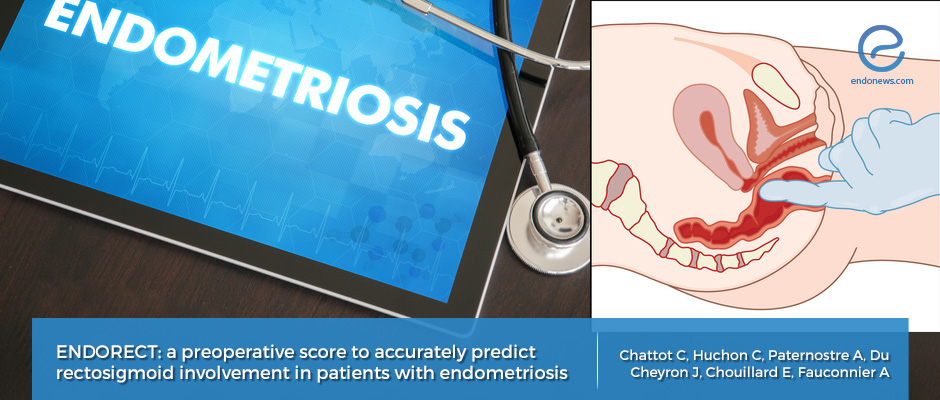ENDORECT scoring system to identify patients at risk for rectosigmoid endometriosis
Jun 18, 2019
ENDORECT: Can a pre-operative score effectively predict rectosigmoid involvement in patients with endometriosis?
Key Points
Highlights:
- Can the ENDORECT scoring system be used as a predictive model for endometriosis patients who suffer from rectosigmoid involvement?
Importance:
- While imaging studies are performed preoperatively to guide surgical treatment, the "ENDORECT score" may allow surgeons to compile standard imaging data to accurately predict rectosigmoid involvement.
What's done here:
- This study aims to assemble various imaging and clinical variables into a risk assessment "ENDORECT score" for rectosigmoid involvement for patients with endometriosis.
Key results:
- Four variables were found to be independently associated with the presence of rectosigmoid endometriosis and were included in the "ENDORECT scoring" system. These included
- Palpation of a posterior nodule on digital examination (8 points),
- A UBESS score of 3 on ultrasonography (7 points),
- Rectosigmoid infiltration found on MRI (9 points), and
- The presence of blood in the stool during menstruation (7 points).
- The odds of a patient having these variables were at least 5 times greater than patients who did not have rectosigmoid involvement.
- According to these variables, researchers classified patients into high-risk (>17), intermediate-risk (7-17), or low-risk (0) categories based on their score
- The predicted risk of having rectosigmoid endometriosis was 71-100% in the high risk, 30-57% in the intermediate risk, and 1-22% in the low-risk groups.
Limitations:
- This is a single-center study and thus required further external validation.
Lay Summary
Patients who suffer from endometriosis may benefit from a preoperative score that predicts rectosigmoid involvement.
A recent paper published by Huchon et al. at Poissy Saint-Germain en Laye, France, recruited 119 women who underwent laparoscopy for endometriosis between 2011 and 2016 with histologic verification. RE involvement was defined as one or more nodules infiltrating the muscle layer of the intestinal wall during complete excisional surgery. Of the 119 women, 47 had RE involvement while 72 did not. Of the patients who underwent RE treatment, 15 underwent bowel resection with primary anastomosis while 30 underwent intramuscular bowel shaving resection. Using a self-assessment questionnaire, diagnostic imaging, and clinical factors, variables such as ovarian mobility on pelvic examination and nodule size were identified that could accurately predict patients who are more likely to have rectosigmoid involvement.
Four variables were seen to be independently associated with RE: palpation of a posterior nodule on digital examination (aOR=5.6; 95%CI [1.7–21.8]), a UBESS score of 3 on ultrasonography (aOR=4.9; 95%CI [1.4–19.8); RE infiltration on MRI (aOR=6.8; 95%CI [2–25.5]); and presence of blood in the stool during menstruation (aOR=5.2; 95%CI [1.3–24.7]). Using these four variables, researchers devised a risk calculator identifying three risk groups: the high-risk group (score>17) had a probability of RE of 100% with a specificity of 100; the intermediate-risk group (score: 7–17) had a probability of rectosigmoid involvement of 42%; and the low-risk group (score=0), with a sensitivity of 97% and a probability of 5%.
According to the risk group that a patient falls upon, surgical management may differ. According to authors, if the patient fell under the low-risk category, they may be eligible for resection without additional imaging modalities to determine RE involvement (such as endorectal ultrasound, CT, enteroclysis).
In the case of intermediate risk, the authors suggested this group may benefit from additional imaging or re-examination by a specialized endometriosis surgeon in case of possible rectosigmoid lesions being visualized during the surgery. These suggestions should be subject to further study using the ENDORECT scoring system as a tool to examine clinical outcomes.
The paper was recently published in the journal "Human Reproduction Open".
Research Source: https://www.ncbi.nlm.nih.gov/pubmed/30968062
endometriosis surgery imaging risk DIE

